Sarah Pretsky, Michael Tanz, and Isaiah Yisrael
Part 1: Introduction
This project considers the difference between the products sold at pharmacies at Plaza Fiesta and other chain pharmacies in Atlanta. Plaza Fiesta is located on Buford Highway in DeKalb County of greater metropolitan Atlanta, specifically in the neighborhood of Brookhaven. Based on information from the United States Census Bureau on foreign-born populations, approximately 40% of Brookhaven’s population is foreign-born. The majority of these people originate from Spanish-speaking countries like Mexico, Guatemala, Peru, Honduras, and Spain and the influence of their native languages can be seen throughout this neighborhood and especially at Plaza Fiesta.
Upon our first visit to Plaza Fiesta, we were taken aback by the mini civilization existing in the 350,000-square-foot shopping mall. At Plaza Fiesta, retailers sell products to fit every need, creating a microcosm for Latino life to exist independently of the rest of society. In this space, we were especially surprised by the number of pharmacies. While there was only one market and a few Western clothing stores, there were many health-related stores. Of the 202 businesses at Plaza Fiesta, 20 are categorized as health stores, or rather salud in Spanish. This significant number of health stores at the shopping mall led us to question the significance of these specialized Hispanic health stores. Furthermore, since each kiosk at Plaza Fiesta targets Spanish-speaking customers, we wondered how these health stores differed from other pharmacies throughout Atlanta like CVS. Ultimately, these curiosities led us to develop a study that examines the differences in products sold at pharmacies in Plaza Fiesta and throughout greater Atlanta using a comparative approach.
Analysis of existing scholarship on analogous landscape
While Hoffman’s (2017) “Pharmaceuticals and Tourist Spaces: Encountering the Medicinal in Cozumel’s Linguistic Landscape” is not exactly analogous to our investigation of Plaza Fiesta, he nevertheless offers perspectives and concepts applicable to our understanding of Plaza Fiesta. In comparing his linguistic landscape to ours, we were able to view the meaning behind signage and advertising more critically and understand how retailers and manufacturers tailor semiotic choices to reach their target markets.
Question
How do the products sold at pharmacies at Plaza Fiesta differ from the products at generic pharmacies in the Atlanta area? How are these pharmacies different based on the demographic they are targeting their sales towards, and how does the language about health differ among these linguistic communities?
Part 2: Research design
We conducted our research by returning to Plaza Fiesta after a preliminary visit and collecting data by taking photographs of recurring, noticeable, or prominent aspects at the pharmacies we visited. We paid the most attention to signs and products; signs advertising products at the front of stores and denoting sections of stores, and products displayed most obviously, for example, on the top shelf, at the front of the window, or advertised as a discount. Furthermore, we made sure to go to the five largest and most centralized pharmacies at Plaza Fiesta to ensure that we captured all sources of data. While we tried to take as many photos as possible, we were not able to record every sign at our site. This was due to the sheer number of products, but another factor at play was a concern for how shopkeepers and shoppers perceived us. As we did not make any purchases at Plaza Fiesta, we felt a bit uncomfortable lingering too long in any one pharmacy, and we felt apprehensive about explaining the nature of our study as well.
At CVS, we followed the same procedure, this time taking photos of the same types of products we found at Plaza Fiesta, to form a comparison. A notable difference between CVS and Plaza Fiesta in terms of data collection was that there were no CVS workers in the aisles as we took photos, so we didn’t feel as awkward as in Plaza Fiesta. Additionally, we felt free to take as much time as we needed and not rush through the aisles like at Plaza Fiesta. While the scope of this project does not allow for a quantitative comparison between the two locations, we will qualitatively analyze the similarities and differences between CVS and Plaza Fiesta and the cultural and linguistic significance of these discrepancies for their respective target audiences.
Part 3: Results
Plaza Fiesta results
The photos gathered at Plaza Fiesta show a variety of products and trends. At the pharmacies in Plaza Fiesta, the majority of the products that were prevalent in our photographs fall into four main categories: natural remedies, health kits, religiously related objects, and name-brand medicines.
Natural remedies
There were many natural remedies available, such as tea leaves for various ailments, organic digestive products like chia or flax, and body treatments like massages to deal with physical pain. Many of these products we packaged simply in clear plastic bags with the name of the herb and the illness it is meant to treat. The herbs were dried out but appeared to be as close to their natural form as possible. These natural remedies occupied a large part of the stores, in many cases 30-40%, and were displayed on high shelves or in the center of the room (Figure 1).
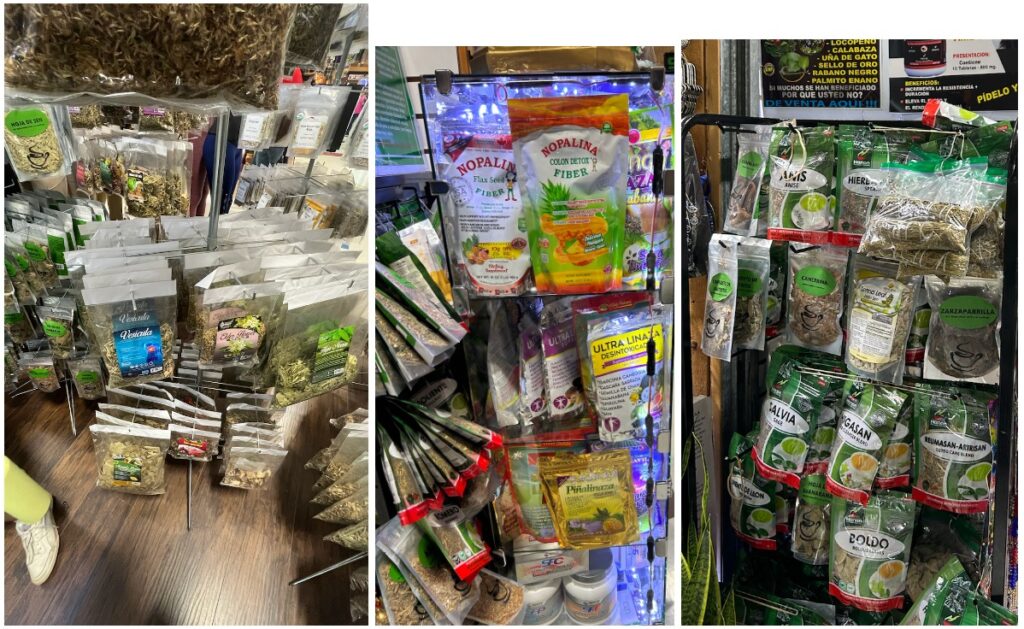
Health kits
At every pharmacy, we found a selection of kits that appear to be designed to treat specific conditions like diabetes, high blood pressure, lung issues, fertility, and more. Often advertising “2-in-1” or “3-in-1,” these boxes generally contained two or more medicines or products, all treating the same common issue. The placement of these kits was different at each store, at some the kits were propped up on shelves, and at others, they lay flat on shelves. Each kit had different coloring and advertising, but generally, these kits used bright, strong colors like red, blue, green, pink, and yellow and were decorated with lots of pictures of various body parts or attractive models (Figure 2).
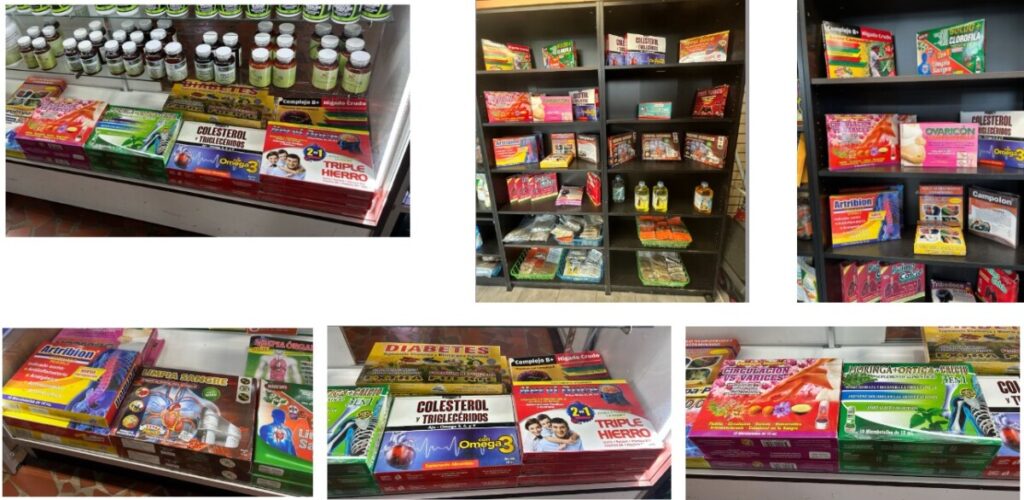
Religiously related
A few pharmacies at Plaza Fiesta displayed Bibles, statues of Jesus Christ, or other religious objects next to their health goods. The presence of religious objects was limited to only a few stalls. However, where these objects were present, they were placed in the front of the stores, in large window cases, or on high shelves. There was no additional signage explaining the significance of the religious paraphernalia (Figure 3).
Figure 3
Name brand medication
There were very few name-brand medications at the pharmacies in Plaza Fiesta. Our photographs only show evidence of these products at one store which is much less frequent than the other types of products. At this one pharmacy, Advil, Tylenol, Claritin, and similar products were kept behind the checkout counter, which decentralized them and made them harder to access. Additionally, there were a few products targeted for kids but not a large notable amount (Figure 4).
Figure 4
CVS results
The shelves at CVS were stocked with colorful products from top to bottom. The prices of each item were obviously displayed with their corresponding promotions, discounts, and sales. Because CVS has much more display space than pharmaceutical businesses in Plaza Fiesta, entire aisles were dedicated to categories of products. On the other hand, pharmaceutical businesses in Plaza Fiesta displayed products in a much more compact manner, in that products intended to treat two completely different issues could be found next to each other.
Natural remedies
The most natural kind of remedies were vitamin gummies or pills that advertised the health benefits of various plants, herbs, or minerals; however, they were still packaged similarly to the traditional medicines. Lots of these products were labeled as either “women’s” or “men’s” and the women’s products were colored pink while the men’s ones were blue or green (Figure 5).
Figure 5
Health kits
The medication we photographed at CVS does not seem to prefer any specific type of ailment or be sold as a unit to treat certain diseases. Rather, the variety of medication is for general care and a wide range of issues.
Religiously related
We did not notice or observe any overt religiously related objects at CVS.
Name brand medication
Many aisles of the CVS pharmacy were filled with more generic name-brand medication from the floor to the top of the shelf. There was a plethora of Tylenol, Advil, Claritin, and more as well as the CVS brand and kids’ counterparts.
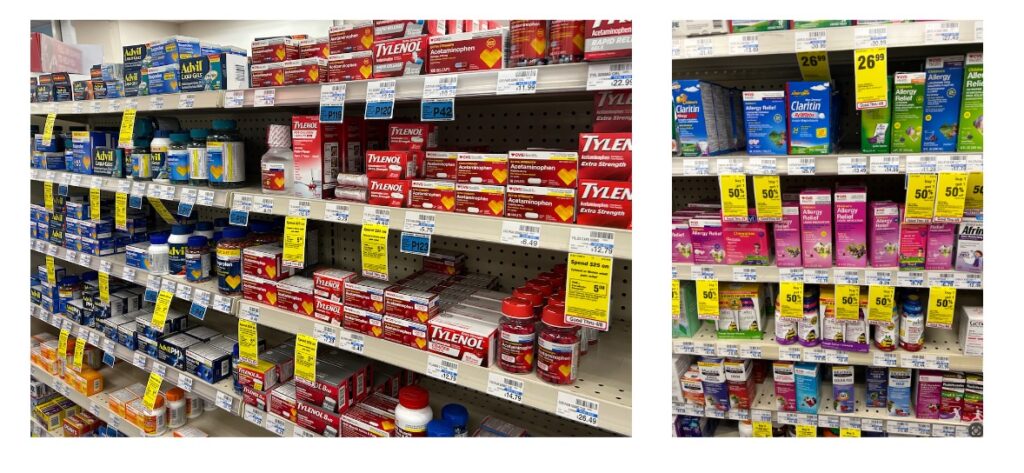
Part 4: Analysis and Discussion
In both Hoffman’s (2017) exploration of Cozumel and our exploration of Plaza Fiesta, we found that pharmacies provide customers with “an opportunity to make personal choices about the pharmaceuticals they wish to medicate themselves with. . . . escape from the prejudice or judgmental eye of the familiar physician or pharmacist” (pp. 74-75). At first, our group felt confused about the seeming lack of licensed pharmacists or medical-grade products at Plaza Fiesta. However, Hoffman’s analysis of pharmacies in Cozumel offers insight into how separation between the medical-industrial complex and pharmacies may appeal to certain consumers.
One of the main striking points of analysis between Plaza Fiesta and CVS were the visual differences between the products sold. The bright flashy titles, large fonts, and colorful boxes of the health kits at Plaza Fiesta established a clear link between the product and the problem they were trying to solve. We found a lot of supplements explicitly targeting their problem: for example, weight loss products with images of a man with a tape measure, cholesterol medicine with pictures of hearts, and neurotrophic migraine vitamins with an image of a glowing red brain and the man touching his head, clearly in pain. This was in stark contrast to the images found in CVS, which often featured a strawberry, cherry, or lemon, signifying the flavor of a certain medicine, but did not usually feature images of people or the targeted body parts. Additionally, another discrepancy was that while the most prominent text on products at Plaza Fiesta cited the specific disease/medical issue, most of the CVS products had a brand name such as Tylenol, Advil, Mucinex, or Claritin, besides the generic ones. There did not seem to be specific brand names on most of the Plaza Fiesta products, and certainly not nearly as prominent as in the CVS products. At one pharmacy there, we did find name-brand American medicine branded in English, but it was off to the side behind a counter, signifying that it was an alternative option. This differed from the presentation at CVS, where name-brand medications and generic counterparts were right next to each other, with the name-brand displayed more prominently at eye level.
A relevant cultural element we noted was the presence of Bibles next to the pharmaceutical products at many of the pharmacies at Plaza Fiesta. This really stood out since we have never seen anything like this at a traditional American pharmacy, and really speaks to the culture and values of the target audience of Plaza Fiesta. While CVS also sells Bibles, they are located in the book section, far away and completely unrelated to the medicines. While some populations might find elements such as nonmedical grade products or prominent religious imagery to be alienating in a pharmaceutical setting, others may welcome the respite from the antiseptic environment of a doctor’s office or a name-brand chain pharmacy.
Another point of contention between the two linguistic landscapes was the idea of homeopathic medicine. At Plaza Fiesta, there was a myriad of plastic bags offering a variety of herbs, teas, plants, and fibers catering to different types of ailments. These homeopathic remedies were presented quite naturally, in clear bags so that customers could see the physical leaves and plants. This sent a different message than the homeopathic counterpart at CVS. While CVS carried a variety of more natural vitamins and natural medicines, their presentation was not drastically different from traditional medicines. They might have different branding, with less flashy and more toned-down branding, but rather than the herbs themselves, these plants were still often made into pills or gummies, far from their natural form.
Lastly, we found it significant that there were five fairly similar pharmacies within the shopping mall, which make up 2.5% of the total stores at Plaza Fiesta. Although 2.5% seems like a small percentage, we found this number significant given the small size of Plaza Fiesta and the similarities in terms of products these stores sold. Due to the overlap between the market stalls selling different goods, it was interesting that there is such a demand for the services and products to warrant this many storefronts. However, the pharmacies did not seem to be very busy and were not attracting customers while we were there. We do not have enough data to make a definitive claim on this, but it would be interesting to delve into the usage, foot traffic, and purchases at these pharmacies in comparison to CVS. Beyond the conceived space, it would be even more significant to perform an ethnographic study of the lived space of Plaza Fiesta and CVS. This would include overcoming some of our hesitations in speaking to the shopkeepers of Plaza Fiesta and conducting interviews with customers and workers, as well as particularly observing the actions of people rather than the products and signage. We would be interested to pursue this project further to deepen our analysis and understanding of the impact of pharmacies on various linguistic communities.
References
Hoffman, L. (2017). Pharmaceuticals and tourist spaces: Encountering the medicinal in Cozumel’s linguistic landscape. ACME: An International Journal for Critical Geographies, 16(1), 59-88.
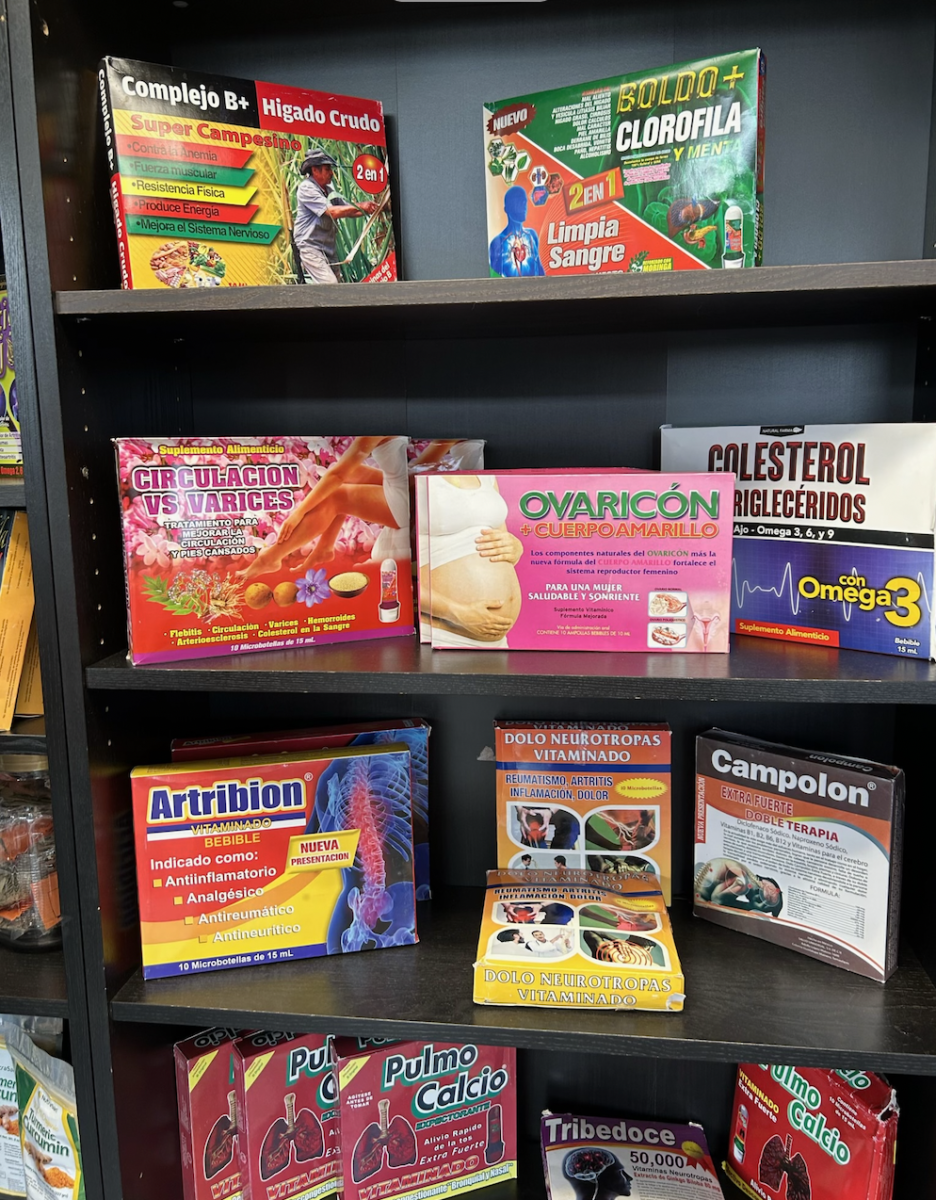
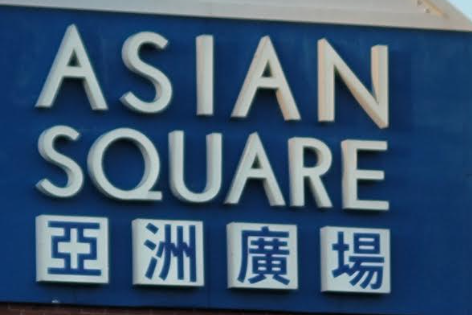



1 Comment
Add Yours →This was a very interesting read and final project topic. The distinction between the products at this pharmacy and products you would see at CVS was a very cool thing to see and your description of the products alongside the photographs exemplified those differences very well. Furthermore, your analysis was very interesting, particularly the prevalence of these pharmacies in the space compared to what you would see of CVS/Walgreens in the greater Atlanta area.